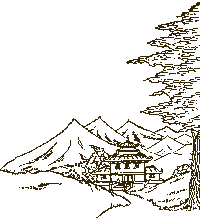| First published in 1981 by Mahayana Publications, Tushita Mahayana Meditation Centre. This article first appeared in Teachings from Tushita, Journal of Tushita Mahayana Meditation Centre.
Born and educated in England, Jeremy Russell’s interest in Buddhism was initially sparked during his first visit to Dharamsala in the early 1970s. He subsequently studied at the Library of Tibetan Works & Archives for several years. He has lived in Dharamsala with his family since 1981, dividing his time between working as an editor for several offices of the Tibetan government-in-exile and leading trekking groups into the nearby mountains. He is editor of Chö-Yang, the Journal of Tibetan Culture. This publication has been translated into Spanish by Ediciones Mahayana, and is now available for download as a pdf file |
CHAPTERS
The Eight Places of Buddhist Pilgrimage
Introduction
Lumbini—birthplace of the Buddha
Bodhgaya—site of Buddha's enlightenment
Sarnath—first turning of the Wheel of Dharma
Rajgir—second turning of the Wheel of Dharma
Shravasti—teachings in the Jetavana Grove
Sankashya—where Lord Buddha descended from Tushita Heaven
Nalanda—site of the great monastic university
Kushinagar—where Buddha entered mahaparinirvana
Conclusion and Books Consulted
INTRODUCTION
 Across the world and throughout the ages, religious people have made pilgrimages. The Buddha himself exhorted his followers to visit what are now known as the four great places of pilgrimage: Lumbini, Bodhgaya, Sarnath and Kushinagar. Many great teachers of the buddhist tradition maintained the practice of pilgrimage and paying respect to the holy sites. Nagarjuna, father of the mahayana, restored the temple in Bodhgaya and protected the bodhi tree, while the great Indian master Atisha, later on as important as Nagarjuna to the Tibetan tradition, also often visited Bodhgaya and indeed attained many realizations there.
Across the world and throughout the ages, religious people have made pilgrimages. The Buddha himself exhorted his followers to visit what are now known as the four great places of pilgrimage: Lumbini, Bodhgaya, Sarnath and Kushinagar. Many great teachers of the buddhist tradition maintained the practice of pilgrimage and paying respect to the holy sites. Nagarjuna, father of the mahayana, restored the temple in Bodhgaya and protected the bodhi tree, while the great Indian master Atisha, later on as important as Nagarjuna to the Tibetan tradition, also often visited Bodhgaya and indeed attained many realizations there.
Of the many places in northern India associated with the Buddha, eight in particular have become special objects of pilgrimage: the four great places above, and four others, namely, Rajgir, Shravasti, Sankashya and Nalanda, each of which is regarded as having been blessed by the Buddha. After the Buddha's passing away and the cremation of his body, the relics were divided into eight portions and various beings erected a great stupa over each. So arose the tradition of eight places of pilgrimage.
The actions of the Buddha in each of these places, recalling which is an important aspect of making pilgrimage, are described within the canons of the scriptures of the various traditions of his teaching, such as the sections on Vinaya, and also in various compendia describing his life. The sites themselves have now been identified once more with the aid of records left by three pilgrims of the past. The great Emperor Ashoka, although initially opposed to Buddhism, later became a zealous follower who in the second decade of his reign made a great pilgrimage to numerous buddhist shrines. As well as other buildings, he left inscribed pillars at each site to indicate the significance of each place. Many remains of these ancient structures survive even today.
In the early fifth century AD, the Chinese pilgrim Fa Hien walked from China to India in search of buddhist books on discipline, the Vinaya. He was followed two centuries later by Hsuan Chwang. Records of the travels of both, which contain detailed accounts of the holy places they visited, have survived in Chinese. Translated into English in the last century, they are now available in most western languages.
The practice of Buddhism flourished long in India, perhaps reaching a zenith in the seventh century AD, at which time the Buddha's teaching began to be firmly established in Tibet. After this it began to decline because of the invading muslim armies, and by the twelfth century the practice of the Dharma had become sparse in its homeland. Thus, the history of the eight places of pilgrimage from the thirteenth to the mid-nineteenth centuries is obscure and they were mostly forgotten. However, it is remarkable that they all remained virtually undisturbed by the conflicts and developments of society during that period. Subject only to the decay of time they remained dormant, waiting for rediscovery.
From the middle of the last century, the Archeological Survey of India, under the auspices of the British Government, and one Englishman in particular—General Sir Alexander Cunningham—unearthed and identified many sites, including the eight places of pilgrimage. Since that time, owing to a renewed Indian interest in Buddhism and the devotion and hardship of many individuals, the pilgrimage sites have been revived. Now, two and a half millennia after the Buddha, there are once more active buddhist establishments and practitioners of the Dharma from many lands resident in all but one of the eight places.
The following account is intended less to present a purely historical record of the places of pilgrimage than to offer some information and perhaps inspiration to other pilgrims, with the wish that this revival may increase.
